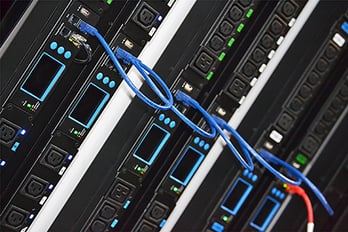 Chatsworth Products (CPI) eConnect® Power Distribution Units (PDUs) are intelligent power distribution products that combine cabinet-level power management, environmental monitoring and electronic access control in multi-tenant and enterprise data centers.
Chatsworth Products (CPI) eConnect® Power Distribution Units (PDUs) are intelligent power distribution products that combine cabinet-level power management, environmental monitoring and electronic access control in multi-tenant and enterprise data centers.
eConnect PDUs offer the quickest and lowest cost deployment among all intelligent rack PDU solutions in the industry. That's, in part, because of its innovative capabilities, like Secure Array™ IP Consolidation Technology.
In order to gain a better understanding of how this technology can benefit your project or application needs, we'll take a deep dive into this technology by answering a few frequently asked questions.
Q. What is Secure Array IP Consolidation Technology?
A. Secure Array IP Consolidation technology is used within CPI eConnect PDUs to allow up to 32 PDUs to share one or two IP addresses with failover capability.
Q. What are the benefits of Secure Array technology?
This technology helps businesses save up to 90% of rack PDU networking costs by minimizing the number of IP addresses. It also allows data centers to save significant time and costs associated with cabling PDUs. In addition, it significantly reduces the time to configure several PDUs.
Q. Which eConnect PDUs have Secure Array technology capability?
A. Secure Array technology is available within all Networked eConnect PDUs. This includes the Monitored eConnect PDU, the Monitored Pro eConnect PDU, Switched eConnect PDU and Switched Pro eConnect PDU.
Q. What is the difference between Secure Array technology and a daisy chaining, and is Secure Array technology more reliable than a daisy chain?
A. In a "daisy chain," only one PDU within the chain has an IP address. If a PDU within the chain loses connectivity, the PDUs downstream of the failed one no longer communicate. Within Secure Array technology, two PDUs within the Array are assigned IP addresses. The first PDU in the Array has an IP address, and it is referred to as the Primary PDU. The last PDU in the chain is also assigned an IP address, and it is referred to as the Alternate Primary. In the event a PDU within the Array loses connectivity, all PDUs upstream of the failure automatically begin to communicate through the Primary PDU. All PDUs downstream of the failure begin communicating through the Alternate Primary PDU. The failover capability makes Secure Array technology much more reliable than a typical daisy chain.
Q. Is it easy to deploy Secure Array technology?
A. Yes. The first PDU in the chain has its Ethernet connection connected to the IP network. The "In" port on the second PDU needs to be connected to the "Out" port on the next PDU using a standard Cat 5/6 cable. The sequence continues, and the last PDU within the chain is again connected to an IP network.
Q. How are the PDUs within the chain detected?
A. The Primary PDU automatically detects all of the PDUs connected within the Array.
Q. How can I view all of the PDUs within the Array?
A. All of the PDUs show up on the "Status - Overview" tab of the web interface of the Primary PDU. Details of any PDU can be seen by clicking on that specific PDU.
Q. Will I be notified if a PDU within the Array loses connectivity?
A. The Primary PDU can be configured to send an alarm if the total number of linked PDUs it detects is lower than the initial configuration.
Q. What happens if the Primary PDU loses connectivity?
A. If the Primary PDU loses connectivity, the Alternate Primary PDU automatically picks up information from all PDUs within the Array. The Alternate Primary PDU can be configured to either maintain its role or pass the role back to the Primary PDU when communication back to the Primary PDU is established.
Q. Are there any best practices for PDUs to be setup within the Secure Array technology?
A. Yes. The PDU with the highest functionality should generally be setup as the Primary PDU. Ideally, the Primary and Alternate Primary PDUs should have the same configuration. It is suggested that all PDUs within the Array are on the same firmware levels.
Q. How do the PDUs within the Array get configured?
A. Configuration parameters from a single PDU can be applied to other PDUs within the Array. New firmware updates can be applied to the Primary PDU only and then pushed to all PDUs in the Array.
Learn more about Secure Array IP Consolidation and other innovative capabilities of CPI's eConnect PDU by watching a video or by visiting the product page.
Click here to contact your local Accu-Tech representative.
Content provided by CPI.


.png?width=58&height=58&name=X_logo_2023_(white).png)
